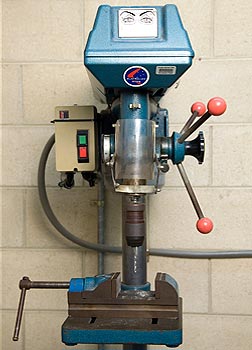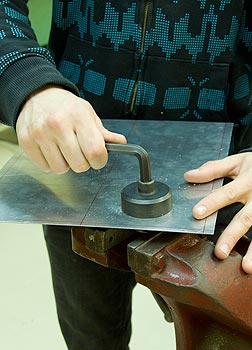Sheet metal
Holes
Drilling press
For drilling holes in sheet metal, a drill press is a better option than using portable drills; it is more accurate and safer. The maximum size hole that can be drilled depends on the thickness and type of sheet metal being used. Larger holes can be made using a hole saw in the chuck of the drill press.
Before operating the drill press, read the operating instructions. You should know how to adjust the platform height, change the drill speed and change drill bits.
Sheet metal should not be hand held during drilling operations. It should be clamped between two pieces of wood using a 'G' clamp or held in a drill vice.

Pedestal drill
Safety:
- Don't wear gloves while drilling.
- Make sure the drill is in proper working order.
- Use a sharp drill bit.
- Always use a face shield or safety glasses.
- Ensure the drill speed is correct for the material.
- Ensure the clamp is tight.
- Do not hold material when drilling.
- Do not wear loose clothing, and remove jewellery.
- Make sure the drill has stopped before making adjustments or cleaning.
- Clean the drill platform after use.

Using a metal punch
Metal punch
The metal punch consists of a die and matching punch that are pulled together by a screw. The metal punch is capable of producing neater holes than a drill bit or hole saw. Dies and cutters are available for punching out square, round or other shaped holes. A different die and punch is required for each hole and size.
To use the punch, first drill a guide hole, then place the die on one side of the sheet and the punch on the other side. Insert the screw through the punch, the hole in the sheet, and the die. Then tighten the screw until the hole is punched through.



